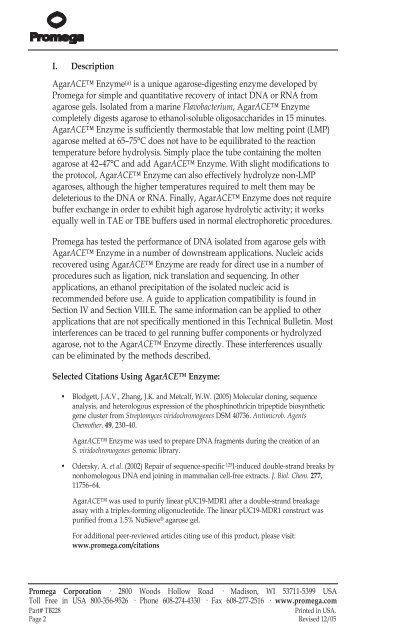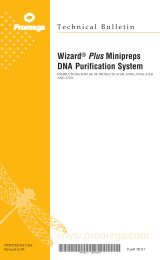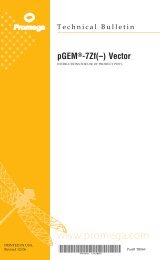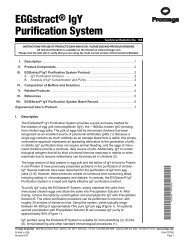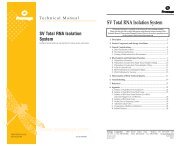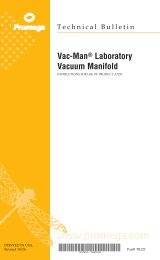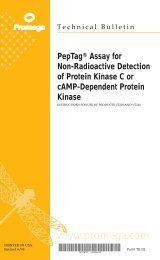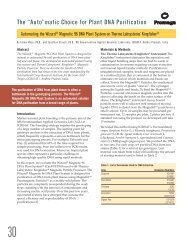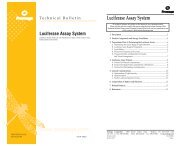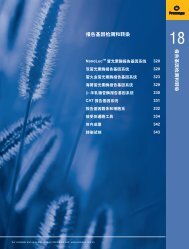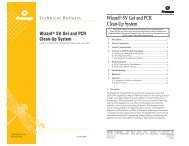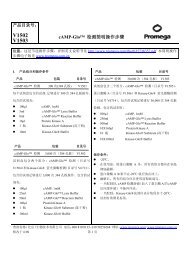AgarACE⢠Agarose-Digesting Enzyme
AgarACE⢠Agarose-Digesting Enzyme
AgarACE⢠Agarose-Digesting Enzyme
You also want an ePaper? Increase the reach of your titles
YUMPU automatically turns print PDFs into web optimized ePapers that Google loves.
I. Description<br />
AgarACE <strong>Enzyme</strong> (a) is a unique agarose-digesting enzyme developed by<br />
Promega for simple and quantitative recovery of intact DNA or RNA from<br />
agarose gels. Isolated from a marine Flavobacterium, AgarACE <strong>Enzyme</strong><br />
completely digests agarose to ethanol-soluble oligosaccharides in 15 minutes.<br />
AgarACE <strong>Enzyme</strong> is sufficiently thermostable that low melting point (LMP)<br />
agarose melted at 65–75°C does not have to be equilibrated to the reaction<br />
temperature before hydrolysis. Simply place the tube containing the molten<br />
agarose at 42–47°C and add AgarACE <strong>Enzyme</strong>. With slight modifications to<br />
the protocol, AgarACE <strong>Enzyme</strong> can also effectively hydrolyze non-LMP<br />
agaroses, although the higher temperatures required to melt them may be<br />
deleterious to the DNA or RNA. Finally, AgarACE <strong>Enzyme</strong> does not require<br />
buffer exchange in order to exhibit high agarose hydrolytic activity; it works<br />
equally well in TAE or TBE buffers used in normal electrophoretic procedures.<br />
Promega has tested the performance of DNA isolated from agarose gels with<br />
AgarACE <strong>Enzyme</strong> in a number of downstream applications. Nucleic acids<br />
recovered using AgarACE <strong>Enzyme</strong> are ready for direct use in a number of<br />
procedures such as ligation, nick translation and sequencing. In other<br />
applications, an ethanol precipitation of the isolated nucleic acid is<br />
recommended before use. A guide to application compatibility is found in<br />
Section IV and Section VIII.E. The same information can be applied to other<br />
applications that are not specifically mentioned in this Technical Bulletin. Most<br />
interferences can be traced to gel running buffer components or hydrolyzed<br />
agarose, not to the AgarACE <strong>Enzyme</strong> directly. These interferences usually<br />
can be eliminated by the methods described.<br />
Selected Citations Using AgarACE <strong>Enzyme</strong>:<br />
• Blodgett, J.A.V., Zhang, J.K. and Metcalf, W.W. (2005) Molecular cloning, sequence<br />
analysis, and heterologous expression of the phosphinothricin tripeptide biosynthetic<br />
gene cluster from Streptomyces viridochromogenes DSM 40736. Antimicrob. Agents<br />
Chemother. 49, 230–40.<br />
AgarACE <strong>Enzyme</strong> was used to prepare DNA fragments during the creation of an<br />
S. viridochromogenes genomic library.<br />
• Odersky, A. et al. (2002) Repair of sequence-specific 125 I-induced double-strand breaks by<br />
nonhomologous DNA end joining in mammalian cell-free extracts. J. Biol. Chem. 277,<br />
11756–64.<br />
AgarACE was used to purify linear pUC19-MDR1 after a double-strand breakage<br />
assay with a triplex-forming oligonucleotide. The linear pUC19-MDR1 construct was<br />
purified from a 1.5% NuSieve ® agarose gel.<br />
For additional peer-reviewed articles citing use of this product, please visit:<br />
www.promega.com/citations<br />
Promega Corporation · 2800 Woods Hollow Road · Madison, WI 53711-5399 USA<br />
Toll Free in USA 800-356-9526 · Phone 608-274-4330 · Fax 608-277-2516 · www.promega.com<br />
Part# TB228<br />
Printed in USA.<br />
Page 2 Revised 12/05


